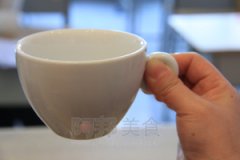General knowledge of coffee roasting introduction to the oil yield and freshness of coffee beans
When we open a can of coffee beans, we sometimes see coffee beans wrapped in a thin layer of fat. It seems that the oil evenly distributed on the surface of coffee beans is actually not oil, but a water-soluble organic substance that looks like oil. Coffee oil itself contains many aromatic ingredients of coffee, which can be dissolved in water, so the surface of your brewed coffee will not be covered with greasy grease. There are two reasons for the emergence of oilbeans. Stale shallow baked beans, fresh deep baked beans. The following in-depth discussion.
Fresh shallow roasted beans with light roasting heat and light brown appearance are dry and will not produce oil after baking. About six days after baking, they begin to appear the phenomenon of dotted oil (there are dotted oil droplets on one side of the coffee bean). Slight dotted oil does not mean that it is not fresh, but sometimes the flavor of shallow roasted coffee beans is at its peak. Continue to put, more than two weeks after the oven, the surface of shallow baked beans gradually covered with a bright glow, at this time the flavor of shallow baked beans has begun to decline, should avoid buying.
Fresh deep-baked beans with dark brown appearance show slightly glossy appearance after baking, and a large amount of oil begins to appear on the surface from the second day to the fifth day after baking. The well-oiled deep-baked beans do not mean that they are not fresh. On the contrary, the deep-baked beans will gradually dry out three weeks after they are baked, and finally become dry-flavored beans. Therefore, if you see coffee beans that are dry but dark brown in appearance, please pay special attention to whether they are marked with the date of baking, which is most likely to be spoiled beans.
How should we judge the freshness of coffee beans from their appearance? First of all, you should clearly mark the baking date for the product (you should buy products with a baking date of less than one week, and do not trust the shelf life marked on the coffee bag) from coffee roasters who have a brand reputation and emphasize fresh roasting. avoid buying coffee beans with unmarked baking date and unknown freshness.
In addition, excellent coffee bags are usually designed with an one-way exhaust valve (a button-shaped hole in the top of the coffee bag) for coffee beans to discharge naturally occurring carbon dioxide. Point the one-way exhaust valve at the nose, gently squeeze the coffee bag and smell the gas. If it is a charming and fragrant coffee aroma, the freshness will not be a problem. On the contrary, if it does not smell strong enough, or even smells of smelly oil, it means that this bag of coffee has already gone bad and should be avoided.
The appearance of freshly baked shallow baked beans should be dry and oil-free, and the surface of freshly baked deep baked beans should be shiny. When buying coffee beans, the appearance of oil, no oil is a reference index to judge the freshness, but not absolutely. It is the best way to buy freshly roasted coffee beans with a good reputation and a baking date.
Tips:
Even if the shallow baked beans are not fresh and oily, the appearance will gradually dry after a long time (such as three months), and finally return to the dry and non-oily appearance. Thus it can be seen that the appearance of oil is only a reference to judge the freshness of coffee beans, not absolutely.
Important Notice :
前街咖啡 FrontStreet Coffee has moved to new addredd:
FrontStreet Coffee Address: 315,Donghua East Road,GuangZhou
Tel:020 38364473
- Prev

Coffee common sense the correct posture of holding a coffee cup
Just as tea has tea art, drinking coffee also has its unique etiquette, and how to get the coffee cup correctly is the detail that we are most likely to ignore. The design of the general cup handle of the more traditional Italian coffee cup is quite special, which is different from our other cups. The handle of the traditional coffee cup usually has a small hole in the middle, or even no hole. The reason for this design lies in the coffee cup.
- Next

Coffee basic knowledge black coffee roasted by charcoal fire
The roasting method of charcoal coffee is a unique coffee roasting method in Japan. The coffee is soft and mild, with charcoal aroma that is characteristic of this baking. The disadvantages of using charcoal to bake coffee: the cost of using charcoal is higher than that of gas, the production is small, and it is difficult to adjust the firepower of charcoal. It is better to use long fruit wood carbon; bamboo charcoal has stronger firepower and far infrared than charcoal. Charcoal burning and gas baking coffee beans, there are very large
Related
- Beginners will see the "Coffee pull flower" guide!
- What is the difference between ice blog purified milk and ordinary milk coffee?
- Why is the Philippines the largest producer of crops in Liberia?
- For coffee extraction, should the fine powder be retained?
- How does extracted espresso fill pressed powder? How much strength does it take to press the powder?
- How to make jasmine cold extract coffee? Is the jasmine + latte good?
- Will this little toy really make the coffee taste better? How does Lily Drip affect coffee extraction?
- Will the action of slapping the filter cup also affect coffee extraction?
- What's the difference between powder-to-water ratio and powder-to-liquid ratio?
- What is the Ethiopian local species? What does it have to do with Heirloom native species?

